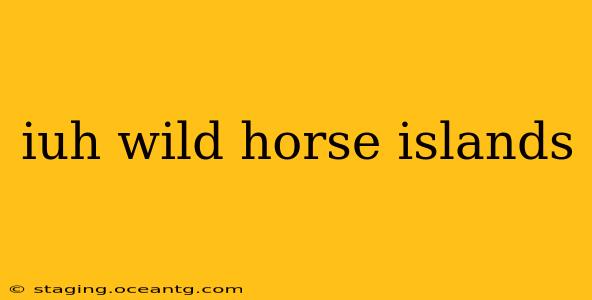The Iuhea Wild Horse Islands, while not an officially recognized geographical location, likely refers to a less-known or regionally specific area featuring wild horses. This guide aims to provide information on wild horses in island environments, addressing common questions and offering insights into their unique circumstances. To accurately answer your question, please provide more details about the specific location you're interested in. Knowing the region, country, or even a more specific name would drastically improve the accuracy of the information provided.
Where are wild horses found on islands?
Wild horses, or feral horses, can be found on islands across the globe, often having descended from domestic horses that escaped or were intentionally released. Their presence varies significantly depending on factors such as suitable habitat, food sources, and the absence of significant predators. Some notable examples include:
- Assateague Island (USA): Famous for its wild horses, these animals are a significant tourist attraction. Their origin is debated, but likely includes escaped or shipwrecked horses.
- Isle Royale (USA): While not currently populated by horses, Isle Royale historically had horses introduced, demonstrating the possibility of horses inhabiting island environments.
- Various islands in the Mediterranean: Several Mediterranean islands have populations of feral horses, often resulting from escaped domestic horses. The specifics can vary greatly depending on the island.
It's vital to remember that the specific locations of wild horse populations are dynamic; some populations thrive, others dwindle or disappear.
What are the challenges faced by island wild horses?
Island ecosystems present unique challenges for wild horse populations. These include:
- Limited Resources: Islands often have limited food and water resources, leading to competition and potential starvation, particularly during droughts.
- Inbreeding: Small, isolated populations are susceptible to inbreeding, reducing genetic diversity and increasing the risk of genetic diseases.
- Human Interference: Tourism, development, and other human activities can disrupt habitats and threaten the survival of island wild horse populations.
- Disease: Island populations can be particularly vulnerable to diseases, as their limited genetic diversity may make them less resistant.
What are the conservation efforts for island wild horses?
Conservation efforts vary depending on the specific island and its wild horse population. Common strategies include:
- Population Management: Controlling the population size through fertility control or selective culling helps prevent overgrazing and maintain a healthy ecosystem.
- Habitat Protection: Preserving and restoring habitats ensures adequate resources for the horses.
- Disease Prevention: Monitoring for and managing diseases is crucial for preventing outbreaks.
- Public Awareness: Educating the public about the importance of wild horse conservation can help to build support for conservation efforts.
How can I learn more about specific islands with wild horses?
To learn more about specific island locations with wild horses, you'll need to provide more details. A good starting point would be to search online using the name of a specific island or region combined with keywords like "wild horses," "feral horses," or "equine conservation." Scientific databases and conservation organization websites often contain detailed information about specific populations. Remember always to prioritize responsible and ethical viewing of wild animals, avoiding disruptive behaviors that could harm the animals or their environment.
This information is intended as a general overview. The specific details regarding "Iuhea Wild Horse Islands" require more information to be accurately addressed. Please provide additional details to allow for a more precise and helpful response.
